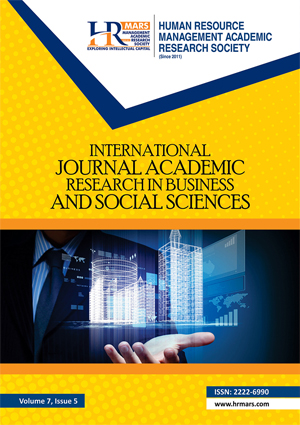
ISSN: 2222-6990
Open access
The objective of this study is to investigate the interaction between AI tools and undergraduate English majors in Chinese universities during their literary studies and examine the effectiveness and sustainability of such interaction. The present study attempts to demonstrate how AI technology can be integrated to enhance literary comprehension and analytical skills in English literature courses for Chinese undergraduate students, evaluate the benefits and challenges of implementing AI-assisted learning in this specific context, and illustrate innovative teaching approaches through authentic classroom case studies from Chinese higher education institutions. By analyzing various AI applications in literary education and their impact on Chinese students’ learning experience, this research provides a practical AI-assisted teaching framework to Chinese educators and contributes to the development of AI-enhanced literary education in Chinese universities.
Ai, Y., Liu, X., & Zhao, R. (2024). Interactive learning: Harnessing technology to alleviate foreign language anxiety in foreign literature education. Interactive Learning Environments, 32(6), 1–15.
Alhalangy, A. G. I., & AbdAlgane, M. (2023). Exploring the impact of AI on the EFL context: A case study of Saudi universities. Journal of Intercultural Communication, 23(2), 41–49.
Alnasib, B. N. M., & Alharbi, N. S. (2024). Challenges and motivation: Assessing Gemini's impact on undergraduate EFL students in classroom settings. World Journal of English Language, 14(5), 501–505.
Blythe, H. (1988). The chivalric narrator of "A Rose for Emily." University of Mississippi Studies in English, 6, 280–284.
Brenner, S. (2024, December 4). Professor uses AI to transform teaching, foster community in comparative literature. UCLA Newsroom. https://newsroom.ucla.edu/stories/comparative-literature-zrinka-stahuljak-artificial-intelligence
Burduck, M. (1990). Another view of Faulkner's narrator in "A Rose for Emily." University of Mississippi Studies in English, 8, 209–211.
Carter, R., & Long, M. N. (1991). Teaching literature. Longman Group.
Chen, M., & Yuan, Z. (2022). Teaching mode of English language and literature based on artificial intelligence technology in the context of big data. Mobile Information Systems, 2022, Article ID 1275368, 1–11.
Clark, L., Lee, D., & Taylor, S. (2019). The state of speech in HCI: Trends, themes and challenges. Interacting with Computers, 31(4), 349–371.
Cox, S. (2021). Online education and e-learning strategies: Challenges and opportunities in higher education. International Journal of Educational Technology in Higher Education, 18(3).
Dimock, W. C. (2020). AI and the humanities. PMLA/Publications of the Modern Language Association of America, 135(3), 449–454.
Eagleton, T. (2003). Literary theory: An introduction (2nd ed.). Blackwell.
Egara, F. O., & Mosimege, M. (2024). Exploring the integration of artificial intelligence-based ChatGPT into mathematics instruction: Perceptions, challenges, and implications for educators. Education Sciences, 14(7), 742.
Fikray, F. M., & Habil, H. (2022). The implementation of literature teaching approaches in the ESL classroom: A systematic review. LSP International Journal, 9(1), 149–165.
Gibson, B., & Green, C. N. (2024). Teaching literature in the age of AI: A collaborative approach to engaged learning. In K. Sacco et al. (Eds.), Navigating AI in academic libraries: Implications for academic research (pp. 179–210). IGI Global.
Grassini, S. (2023). Shaping the future of education: Exploring the potential and consequences of AI and ChatGPT in educational settings. Education Sciences, 13(7), 692.
Hu, Y. (2023). Literature in the age of artificial intelligence: A preliminary study on the big language model AI. In Proceedings of the 2023 9th International Conference on Humanities and Social Science Research (ICHSSR 2023) (pp. 1781–1787). Atlantis Press.
Kussin, H., Ali, Z., & Azim, M. (2023). Systematic literature review: Integrating artificial intelligence (AI) in teaching and learning of language. AJELP: Asian Journal of English Language and Pedagogy, 11(1), 108–119.
Laquintano, T., & Vee, A. (2024). AI and the everyday writer. PMLA, 139(3), 527–532.
Mehrpouyan, A. (2023). Enhancing online English language and literature classrooms: Effective and practical teaching strategies. Education and Information Technologies, 28(4127–4141).
Ministry of Education Foreign Language Teaching Advisory Board. (2018). National standards for teaching quality of foreign language programs in higher education. Ministry of Education of the People’s Republic of China.
Oppenlaender, J., Ghosh, A., & Pierson, D. (2024). Prompting AI art: An investigation into the creative skill of prompt engineering. International Journal of Human-Computer Interaction, 40(1), 1–23.
Perlow, S. (2024). Generative theories, pretrained responses: Large AI models and the humanities. PMLA, 139(3), 548–552.
Roy, D., & Putatunda, T. (2023). From textbooks to chatbots: Integrating AI in English literature classrooms of India. Journal of e-Learning and Knowledge Society, 19(3), 65–73.
Showalter, E. (2002). Teaching literature. Wiley-Blackwell.
Thomas, H. J. (2024). “Is there a curriculum voice to reclaim?”: Exploring the curriculum-teacher space in secondary English literature education in England (PhD thesis). Bath Spa University.
Ukat, J. A., & Ismail, H. H. (2022). Teaching literature in Malaysian English classrooms: A review on its challenges and opportunities. International Journal of Academic Research in Business and Social Sciences, 12(11), 1991–2004.
Heerden, I., & Bas, A. (2021). AI as author: Bridging the gap between machine learning and literary theory. Journal of Artificial Intelligence Research, 71, 175–189.
Xiu-Yi, W. (2024). AI in L2 learning: A meta-analysis of contextual, instructional, and social-emotional moderators. System.
Zawacki-Richter, O., Marin, V. I., Bond, M., & Gouverneur, F. (2019). Systematic review of research on artificial intelligence applications in higher education – Where are the educators? International Journal of Educational Technology in Higher Education, 16(1), 1–39.
Zeng, W. (2024). Literary criticism of AI: Paths, paradigms, and key points. Social Sciences Digest, 11, 60–62.
Zhang, X., Li, J., & Liu, H. (2023). Design and application of intelligent classroom for English language and literature based on artificial intelligence technology. Applied Artificial Intelligence, 37(1).
Xu, L., Mani, M., & Singh, H. K. a/p J. (2025). AI-Enhanced Literary Education: Unveiling the Potential of Generative AI in Literary Education. International Journal of Academic Research in Business and Social Sciences, 15(1), 1780–1792.
Copyright: © 2025 The Author(s)
Published by HRMARS (www.hrmars.com)
This article is published under the Creative Commons Attribution (CC BY 4.0) license. Anyone may reproduce, distribute, translate and create derivative works of this article (for both commercial and non-commercial purposes), subject to full attribution to the original publication and authors. The full terms of this license may be seen at: http://creativecommons.org/licences/by/4.0/legalcode